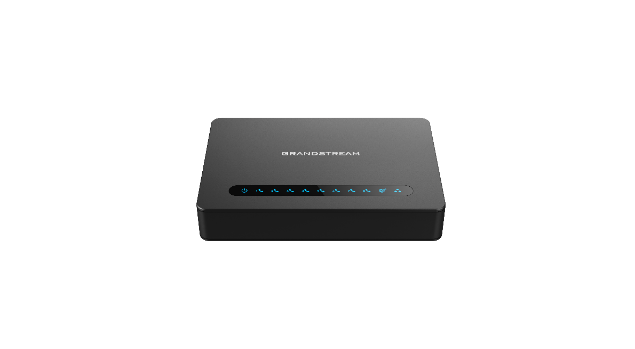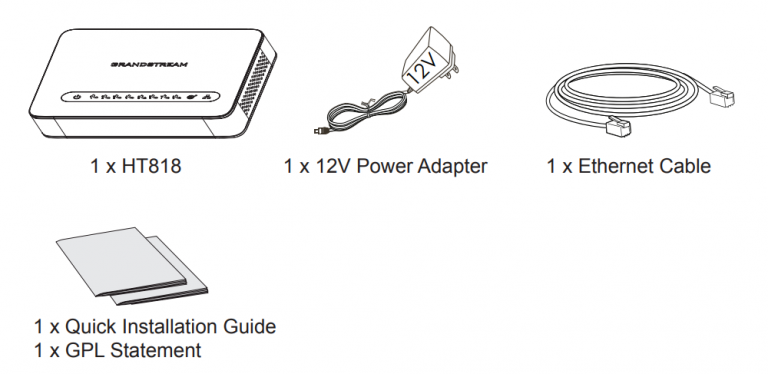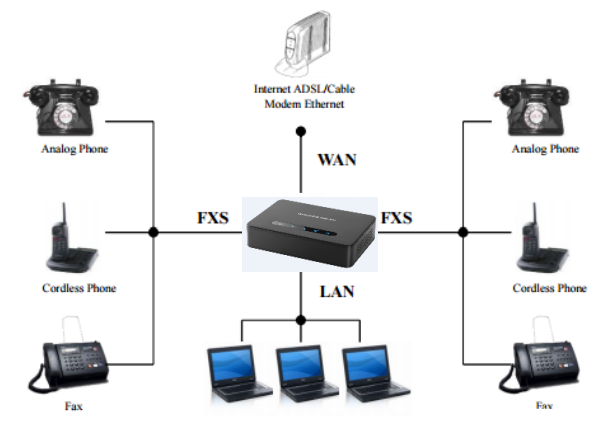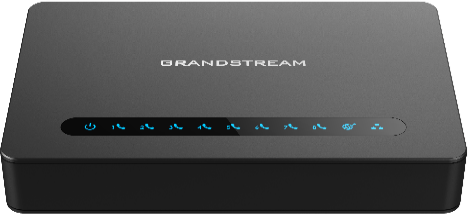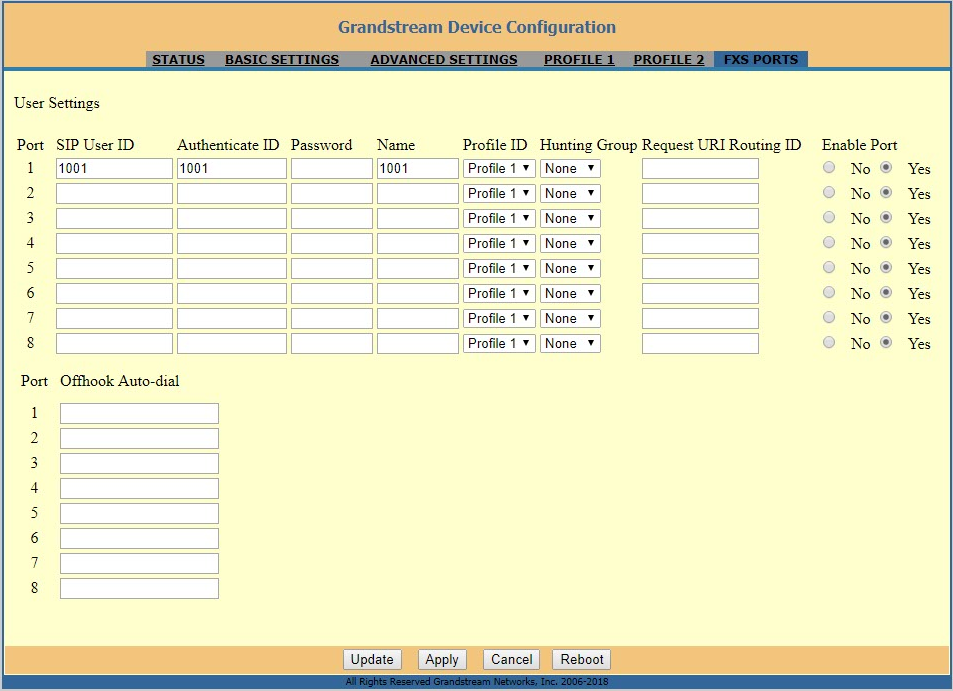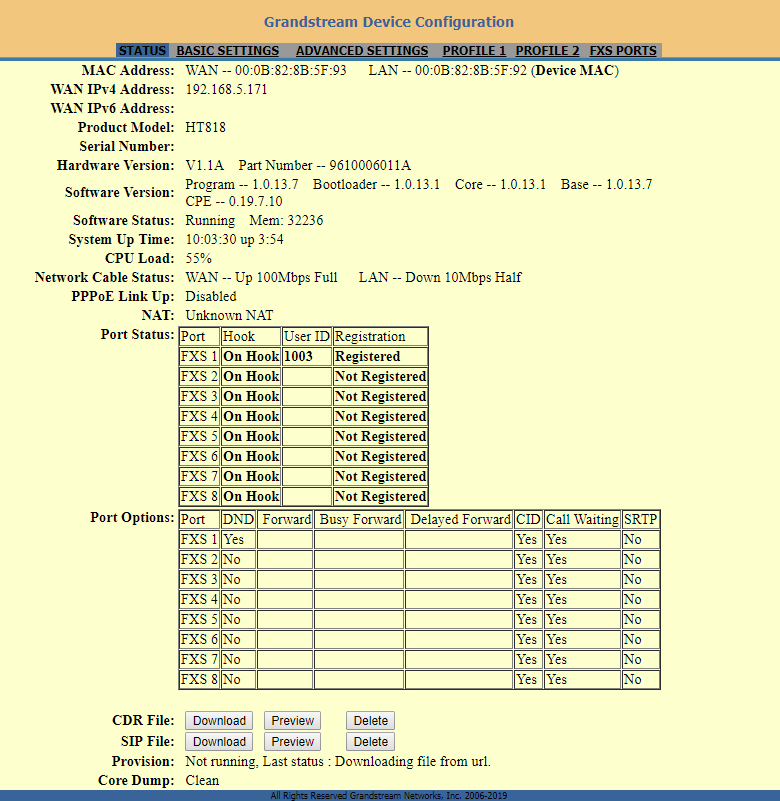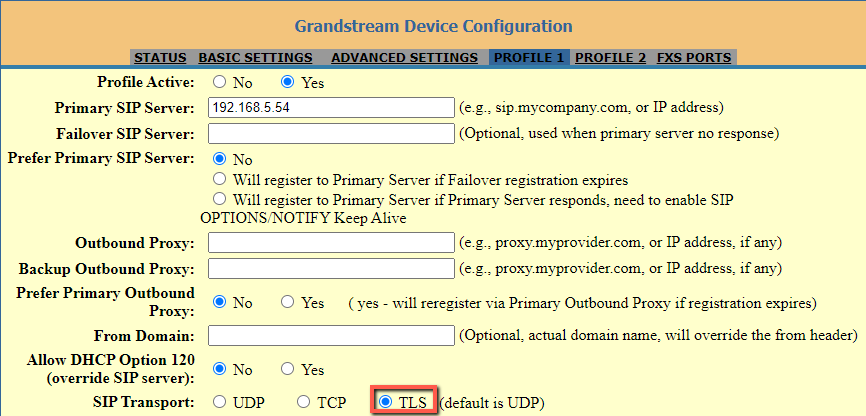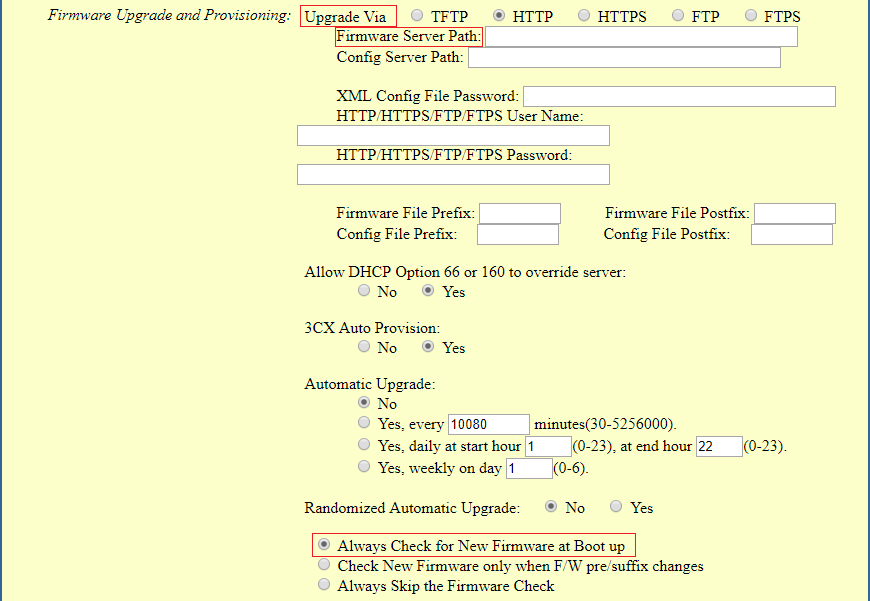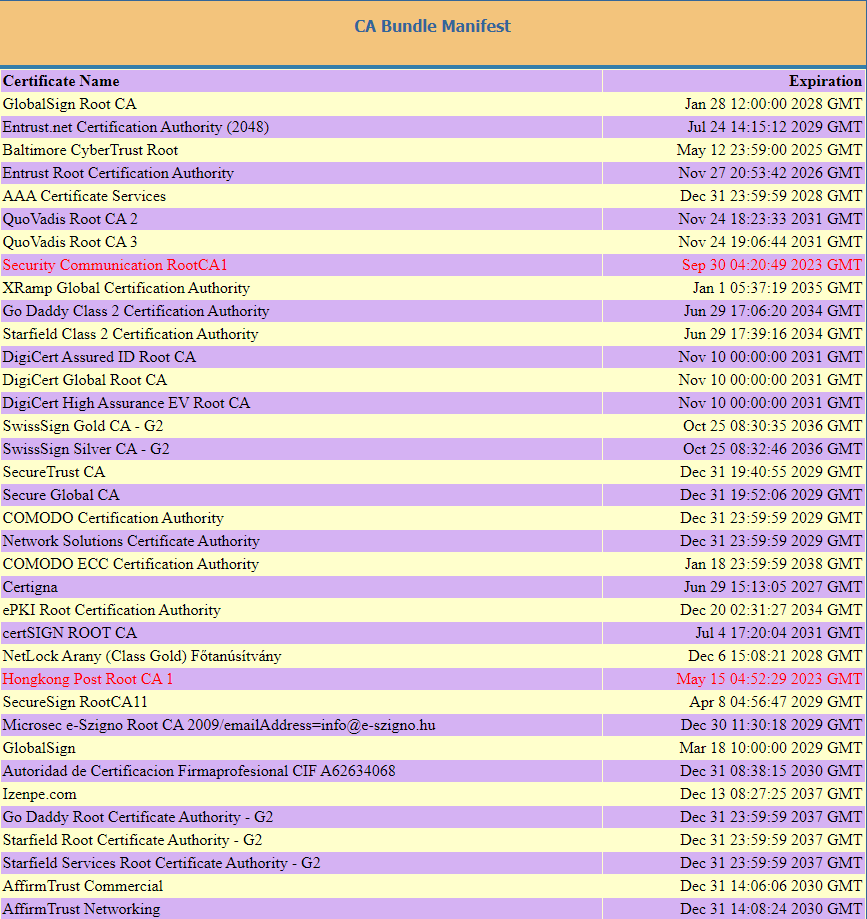|
|
|
|
Activates / Deactivates the accounts. The FXS port configuration will not change if disabled, although the port will not be operational, in this state, there will be no dial tone when picking up the analog phone and making/receiving calls will not be possible.
|
|
|
Configures SIP server IP address (Supports both IPv4 and IPv6 addresses) or domain name provided by VoIP service provider. (For example: sip.mycompany.com, IPv4:192.168.5.170, or IPv6: fe80::20b:82ff:fe75:211d). This is the primary SIP server used to send/receive SIP messages from/to HT81x.
|
|
|
Defines failover SIP server IP address (Supports both IPv4 and IPv6 addresses) or domain name provided by VoIP service provider. (For example: sip.mycompany.com, IPv4:192.168.5.170, or IPv6 fe80::20b:82ff:fe75:211d:). This server will be used if primary SIP server becomes unavailable.
|
Prefer Primary SIP Server
|
Selects to prefer primary SIP server. The account will register to the primary Server if registration with the Failover server expires.
-
Will register to Primary Server if Failover registration expires: If failover server registration ends, the client reverts to the main server.
-
Will register to Primary Server if Primary Server responds, need to enable SIP OPTIONS/NOTIFY Keep-Alive: Client registers with the main server if it’s responsive, requiring keep-alive methods.
-
No: The client doesn’t prioritize the main SIP server.
|
|
|
Specifies IP address (Supports both IPv4 and IPv6 addresses) or domain name of outbound Proxy, or media gateway, or session border controller. (For example: proxy.myprovider.com, IPv4: 192.168.5.170, or IPv6: fe80::20b:82ff:fe75:211d). It’s Used by HT818 for firewall or NAT penetration in different network environments. If symmetric NAT is detected, STUN will not work and only outbound proxy can correct the problem
|
|
|
Configures the backup outbound proxy to be used when the “Outbound Proxy” registration fails. (For example: proxy.myprovider.com, or IP address, if any: IPv4: 192.168.5.170/ IPv6: fe80::20b:82ff:fe75:211d). By default, this field is left empty.
|
Prefer Primary Outbound Proxy
|
If the user configures this option to “Yes”, when the registration expires, the device will re-register via primary outbound proxy. By default, this option is disabled.
|
|
|
allows users to add the actual domain name, it will override the from header.This is an optional configuration.
|
Allow DHCP Option 120 (override SIP Server)
|
Configures the HT81x to collect SIP server address from DHCP option 120. Default is No.
|
|
|
Selects transport protocol for SIP packets; UDP or TCP or TLS. Please make sure your SIP Server or network environment supports SIP over the selected transport method. Default is UDP.
|
SIP URI Scheme When Using TLS
|
Specifies if “sip” or “sips” will be used when TLS/TCP is selected for SIP Transport. The default setting is “sips”.
|
Use Actual Ephemeral Port in Contact with TCP/TLS
|
Controls the port information in the Via header and Contact header. If set to “No”, these port numbers will use the permanent listening port on the phone. Otherwise, they will use the ephemeral port for the connection. Default is No.
|
|
|
Indicates type of NAT for each account. This parameter configures whether the NAT traversal mechanism is activated. Users could select the mechanism from No, Keep-alive, STUN, UPnP, VPN, and Auto.
-
No: Disables NAT traversal, potentially causing connection issues for the ATA if it’s behind a NAT router.
-
Keep-alive: Periodically sends signals to maintain the NAT mapping for the ATA, preventing disconnection.
-
STUN: Utilizes the STUN protocol to discover and adapt to NAT settings for seamless VoIP communication.
-
UPnP: Allows the ATA to dynamically configure NAT port mappings, streamlining VoIP traffic.
-
VPN: Requires the ATA to establish a secure VPN connection for VoIP, bypassing NAT restrictions.
-
Auto: Automatically selects the most suitable NAT traversal method based on network conditions, ensuring reliable ATA connectivity.
|
|
|
Selects DNS mode to use for the client to look up server. One mode can be chosen.
A Record (Default): resolves IP Address of target according to domain name.
SRV: DNS SRV resource records indicate how to find services for various protocols.
NAPTR/SRV: Naming Authority Pointer according to RFC 2915.
Use Configured IP: If the SIP server is configured as domain name, device will not send DNS queries, but will use “Primary IP” or “Backup IP” to send SIP message if at least one of them is not empty. It will try to use “Primary IP” first, after 3 tries without any response, it will switch to “Backup IP 1”, then “Backup IP 2”, and then it will switch back to “Primary IP” after 3 retries.
|
DNS SRV use Registered IP
|
When the HT81x is registered using the second SRV record, making an outbound call, it will try the second SRV (registered IP) first. By default, this option is disabled and the DNS SRV will use first SRV instead of the registered IP.
|
|
|
Configure the preferred IP mode when DNS Mode is SRV or NAPTR/SRV.
• Default SIP request will always be sent to the address with the top priority based on the SRV query result, even if this address is different from the registered IP address.
• Saved one until DNS TTL SIP request will always be sent to the registered IP address until DNS TTL expires or registered IP address is unreachable
• Saved on until no response SIP request will always be sent to the registered IP address only until registered IP address is unreachable.
|
|
|
When the primary SBC is up, device will send SIP requests to the primary SBC. If at any point device fails over to the secondary SBC, the SIP requests will stay on the failover SBC for the duration of the failback timer. When the timer expires, device will send SIP requests to the primary SBC, (in minutes. Default is 60 minutes, max 45 days).
|
Register before DNS SRV Failover
|
This feature is used to control whether the device need to initiate a new registration request (following existing DNS SRV fail-over mode) first and then direct the non-registration SIP request (INVITE) to the new successfully registered server or not.
|
|
|
Indicates E.164 number in “From” header by adding “User=Phone” parameter or using “Tel:” in SIP packets, if the HT81x has an assigned PSTN Number.
Disabled: Use “SIP User ID” information in the Request-Line and “From” header.
User=Phone: “User=Phone” parameter will be attached to the Request-Line and “From” header in the SIP request to indicate the E.164 number. If set to “Enable”.
Enabled: “Tel:” will be used instead of “sip:” in the SIP request.
Please consult your carrier before changing this parameter. Default is Disabled.
|
Use Request Routing ID in SIP INVITE Header
|
If set to Yes, device will use the configured [Request URI Routing ID] in the SIP INVITE. This option is usually used under a SIP trunk account’s configuration. Default is No.
|
|
|
Controls whether the HT81x needs to send REGISTER messages to the proxy server. Default setting is Yes.
|
|
|
Controls whether to clear SIP user’s information by sending un-register request to the proxy server. The un-registration is performed by sending a REGISTER message with “Expires=0” parameter to the SIP server. This will unregister the SIP account under the concerned FXS page.Unregister on reboot option can be set to “No”, “All” or “Instance”.
-
Set to “No”: If the “Unregister on reboot” option is set to “No”, it means that the SIP user’s information will not be cleared when the device reboots. In other words, the SIP account will remain registered with the server even after the device is rebooted.
-
Set to “All”: If the “Unregister on reboot” option is set to “All”, it means that all SIP accounts associated with the device will be unregistered when the device reboots. This option clears the SIP user’s information for all the FXS ports on the device.
-
Set to “Instance”: If the “Unregister on reboot” option is set to “Instance”, it means that only the SIP account associated with the concerned FXS port will be unregistered when the device reboots. This option clears the SIP user’s information for only the specific FXS port that is affected by the reboot.
Default value is set to “No”
|
Outgoing Call Without Registration
|
Enables the ability to place outgoing calls even if the account is not registered (if allowed by ITSP); device will not be able to receive incoming calls. Default is No.
|
|
|
Refreshes registration periodically with specified SIP proxy (in minutes). Maximum interval is 65535 minutes (about 45 days).
Default is 60 minutes (or 1 hour).
|
Reregister Before Expiration
|
Sends re-register request after specific time (in seconds) to renew registration before the previous registration expires.
|
SIP Registration Failure Retry Wait Time
|
Sends re-register request after specific time (in seconds) when registration process fails. Maximum interval is 3600 seconds (1 hour).
|
SIP Registration Failure Retry Wait Time upon 403 Forbidden
|
Sends re-register request after specific time (in seconds) when registration process fails with error 403 Forbidden. Maximum interval is 3600 seconds (1 hour). Default is 1200 seconds.
|
Port Voltage Off upon no SIP Registration or SIP Registration Failure
|
Allows users to configure the timer of Port Voltage Off.
For Port Voltage Off upon no SIP, the Valid Range is 0 to 60 with the Default value being 0 ( 0 means the port voltage is never turned off )
|
Delay Time of Port Voltage Off Timer Since Boot
|
Allows users to set a delay time of FXS line voltage when there is no SIP registration.
The valid Range is 0 to 60, and the Default value is 0.
|
Enable SIP OPTIONS/NOTIFY Keep Alive
|
Enables SIP OPTIONS or SIP NOTIFY to track account registration status so the ATA will send periodic OPTIONS/NOTIFY message to server to track the connection status with the server.
|
SIP OPTIONS/NOTIFY Keep Alive Interval
|
Configures the time interval when the ATA send OPTIONS or NOTIFY message to SIP server. The default setting is 30 seconds, which means the ATA will send an OPTIONS/NOTIFY message to the server every 30 seconds. The default range is 1-64800.
|
SIP OPTIONS Keep Alive Max Lost
|
Defines the Number of max lost packets for SIP OPTIONS Keep Alive before re-registration. Between 3-10, default is 3.
|
|
|
Defines Diff-Serv values for SIP and RTP.
SIP DSCP (Diff-Serv value in decimal, 0-63, default 26)
RTP DSCP (Diff-Serv value in decimal, 0-63, default 46)
|
|
|
Defines local port to use by the HT81x for listening and transmitting SIP packets. Default value for FXS 1 is 5060 and 5062 for FXS 2.
|
|
|
Defines the local RTP-RTCP port pair the HT81x will listen and transmit. It is the HT81x RTP port for channel 0.
The default value for FXS port is 5004
|
|
|
Controls whether to use configured or random SIP ports. This is usually necessary when multiple HT81x are behind the same NAT.
|
|
|
Controls whether to use configured or random RTP ports. This is usually necessary when multiple HT81x are behind the same NAT.
|
|
|
This feature allows users to specify the minimum and maximum RTP port ranges that can be used with the
HT device.
The Valid range is between 1024-65535
|
|
|
Allows users to enable RTCP. The default setting is “Yes”.
|
|
|
Allows user to hold or not hold the phone call before referring.
The default setting is Yes.
|
Refer-To Use Target Contact
|
Includes target’s “Contact” header information in “Refer-To” header when using attended transfer. Default is No.
|
Transfer on Conference Hang-up
|
If set to “Yes”, when the phone hangs up as the conference initiator, the conference call will be transferred to the other parties so that other parties will remain in the conference call.
|
Disable Bellcore Style 3-Way Conference
|
Gives the users the possibility of making conference calls by pressing “Flash” key, when it’s enabled by dialing *23 +second callee number. Default is No
|
Remove OBP from Route Header
|
Removes outbound proxy info in “Route” header when sending SIP packets.
|
|
|
Includes “SIP Instance ID” attribute to “Contact” header in REGISTER request as defined in IETF SIP outbound draft.
|
|
|
This feature allows users to set RFC5626 outbound. Enabled “Support SIP Instance ID” and “Support
outbound” which could support RFC 5626
Disabled by Default.
|
|
|
This feature allows users to set RFC5627 GRUU. Enabled “Support SIP Instance ID” and “Support GRUU”
which could support RFC 5627
Disabled by Default.
|
Validate Incoming SIP Messages
|
Validates incoming SIP messages. Default is No.
|
Check SIP User ID for Incoming INVITE
|
Checks SIP User ID in the Request URI of incoming INVITE; if it doesn’t match the HT81x SIP User ID, the call will be rejected. Direct IP calling will also be disabled. Default is No.
|
Authenticate Incoming INVITE
|
Challenges the incoming INVITE for authentication with SIP 401 Unauthorized message.
|
Authenticate Server Certificate Domain
|
Configures whether to validate the domain certificate when download the firmware/config file. If it is set to “Yes”, the phone will download the firmware/config file only from the legitimate server. The default setting is “No”.
|
Authenticate server certificate chain
|
Configures whether to validate the server certificate when download the firmware/config file. If it is set to “Yes”, the phone will download the firmware/config file only from the legitimate server. The default setting is “No”.
|
Allow Incoming SIP Messages from SIP Proxy Only
|
Checks SIP address of the Request URI in the incoming SIP message; if it doesn’t match the SIP server address of the account, the call will be rejected.
|
|
|
Determines if the “Privacy header” will be presented in the SIP INVITE message and if it includes the caller info in this header. If set to Default, it will add Privacy header unless special feature is Telkom SA or CBCOM. Default is Default.
|
Use P-Preferred-Identity Header
|
Specifies if the P-Preferred-Identity Header will be presented in the SIP INVITE message. If set to “default”, the P-Preferred-Identity Header will be omitted in SIP INVITE message when Telkom SA or CBCOM is active. If set to “Yes”, the P-Preferred- Identity Header will always be presented. If set to “No”, it will be omitted. Default setting is: Default.
|
Use P-Access-Network-Info Header
|
With this feature enabled, device will populate the WAN access node with IEE-802.11a, IEE-802.11b in P-Access-Network-Info SIP header.
|
Use P-Emergency-Info Header
|
This feature support of IEEE-48-addr and IEEE-EUI-64 in SIP header for emergency calls.
|
Use P-Asserted-Identity Header
|
When this feature is set to Yes, device will send P-Asserted-Identity Header on the SIP Invite.
|
|
|
Allows users to set up the P-Early-Media Header. Once activated via “Ringback Tone at No Early Media,” the phone will emit a ringback tone if early media RTP packets face obstruction from the intermediary server. Furthermore, the phone will acquire a “P-Early-Media” header within the 180/183 response, indicating “inactive,” “recvonly,” or “gated” values to signify the absence of incoming RTP packets.
Disabled by Default.
|
SIP REGISTER Contact Header Uses
|
Specifies which address (LAN or WAN address) the device will detect to use it in SIP Register Contact Header.
|
|
|
Selects the Caller ID display order which need to be respected by the ATA.
The available options are:
Auto: When set to “Auto”, the ATA will look for the caller ID in the order of P-Asserted Identity Header, Remote-Party-ID Header and From Header in the incoming SIP INVITE.
Disabled: When set to “Disabled”, all incoming calls are displayed with “Unavailable”.
From Header: When set to “From Header”, the ATA will use the FROM header to display the caller ID.
|
|
|
Allows to reset the devices directly through SIP Notify. If “Allow SIP Factory Reset” is set to “YES” under FXS PORT, then the ATA receives the NOTIFY from the SIP server with Event: reset, the HT should perform a factory reset after the authentication.
The authentication in this case can be either with:
The admin password if no SIP account is configured on the HT.
With the credentials of the SIP account if configured on the ATA.
|
Maximum Number of SIP Request Retries
|
This feature allows user to configure the number of SIP retries before failover occurs. (between 1 and 10, default is 2).
|
|
|
Defines T1 timeout value. It is an estimate of the round-trip time between the client and server transactions. For example, the HT81x will attempt to send a request to a SIP server. The time it takes between sending out the request to the point of getting a response is the SIP T1 timer. If no response is received the timeout is increased to (2*T1) and then (4*T1). Request re-transmit retries would continue until a maximum amount of time defined by T2. Default is 0.5 seconds.
|
|
|
Identifies maximum retransmission interval for non-INVITE requests and INVITE responses. Retransmitting and doubling of T1 continues until it reaches T2 value. Default is 4 seconds.
|
|
|
Configures SIP Timer D defined in RFC3261. 0 – 64 seconds. Default is 0.
|
|
|
Defines payload type for DTMF using RFC2833.
|
Preferred DTMF method (in order)
|
Sorts DTMF methods (in-audio, via RTP (RFC2833) or via SIP INFO) by priority.
|
Force DTMF to be sent via SIP INFO simultaneously
|
This option forces the DTMF signals to be sent using the SIP INFO method for better compatibility with VoIP systems.
Disabled by Default.
|
|
|
allows users to config the Inband DTMF Duration and inter-duration.
The default Duration is 100 ms. Valid range: 40-2000 ms.
The default Inter-duration is 50 ms. Valid range: 40-2000 ms.
|
|
|
Allows users to configure the Inband DTMF Tx Gain.
The Valid rand is -12 to 12 db.
The Default value is 0db.
|
DSP DTMF Detector Duration Threshold
|
Allows users to config the DSP DTMF Detector Duration Threshold
The default Duration is 30 ms. Valid range: 20-2000 ms.
The default Inter-duration is 30 ms. Valid range: 20-2000 ms.
|
|
|
Uses above DTMF order without negotiation. Default is No.
|
Generate Continuous RFC2833 Events
|
When enabled the RFC2833 events are generated until key is released.
|
|
|
Default is No. If set to yes, flash will be sent as DTMF event.
|
|
|
When it set to YES it allows the user to perform some call setting when both channels are used while pressing:
“Flash + 1” in order to hang up the current call and resume a call that was held.
“Flash + 2” in order to hold the current call and resume a call that was held.
“Flash + 3” in order to perform 3-way conference.
“Flash + 4” in order to perform attended transfer.
Note: Please refer to the user guide for detailed steps to perform above operations.More additional Digit events were added on the new firmware 1.0.43.10.
|
Enable Call Waiting alert-info In 180 Ringing Response
|
When set to Yes, Alert-Info header will be added in 180 Ringing for Call Waiting case
|
|
|
When this feature is set to Yes, device would be able to set up the 3-way conference call even when device is the callee in the second call. Default is No.
|
|
|
Specifies the auto-dial delay after off hook.
|
|
|
Determines a SIP Extension to notify the SIP server that the HT81x is behind a NAT/Firewall.
|
|
|
Defines NAT IP address used in SIP/SDP messages. It should only be used if required by ITSP.
|
|
|
This feature allows users to configure SIP User Agent. If not configured, device will use the default User Agent header.
|
|
|
Configures the SIP User-Agent Postfix
|
|
|
This feature allows users to configure “User-Agent” in the SIP header field, when this feature is set to“No”, “User-Agent” does not carry a MAC, when this feature is set “Yes except REGISTER”, “User-Agent” in REGISTERSIP header field does not carry MAC but other SIP packet header fields carries MAC, when this
feature is set to “Yes to all SIP”, “User-Agent” in the SIP packet header field will carries the MAC.
|
|
|
This feature allows users to configure MAC Header in the SIP packet header field, when this feature is set to “No” ,the MAC header field is not carried in the SIP packet header field, when this feature is set to “REGISTER Only”, the register packet header field carries the MAC header field but the remaining SIP packets do not carry MAC header fields, when this feature is set to “Yes to all SIP”, the MAC header field is carried in the SIP data packet header field.
|
|
|
Toggles between RFC2543 hold and RFC3261 hold. RFC2543 hold allows to disable the hold music sent to the other side, in this case IP address (0.0.0.0) it will be sent in SDP instead of the IP address of the unit . RFC3261 (a line) will play the hold music to the other side.
|
|
|
Disables receiving a second incoming call when the line is engaged. Default is No.
|
Disable Call Waiting Caller ID
|
Disables displaying caller ID when receiving a second incoming call. Default is No.
|
Disable Call Waiting Tone
|
Disables playing call waiting tone during active call when receiving a second incoming call. The CWCID will still be displayed.
|
Disable Connected Line ID
|
Disables displaying the number of the person answering the phone.
|
Disable Receiver Off Hook Tone
|
Enables / disables the warning to alert that the phone has been left off-hook for an extended period of time.
|
Disable Reminder Ring for On-Hold Call
|
Enables playing the reminder ring.
|
Disable Reminder Ring for DND
|
This feature allows user to disable reminder ring when FXS port is on DND mode. Default is Yes.
|
|
|
Disables use of visual message waiting indicator when there is an unread voicemail message. Default is No.
|
|
|
Configures Visual WMI Type of signal sent to the analog phone to make it turn the lamp ON upon receiving a Voice mail.
Check the phone’s manual to find out what signal is supported, FSK (default) or Neon.
Note: Some phones (depending on the model of the analog phone) when this feature is set to NEON it might auto ring (short beeps) when there is a voice mail available for that FXS port where it is connected.
|
|
|
When set to Default, device will play Stutter Dial Tone when there is voicemail, if set to Special Proceed Indication Tone, device will play the configured special proceed indication tone upon user offhook when there is voicemail
|
Ringback Tone at No Early Media
|
Allows users to customize the “Ringback Tone at No Early Media” setting. Upon activation with “Use P-Early-Media Header,” the phone will emit a ringback tone if early media RTP packets encounter obstruction from the intermediate server. The phone also obtains a “P-Early-Media” header in the 180/183 response, indicating values like “inactive,” “recvonly,” or “gated,” signifying the absence of incoming RTP packets.
Disabled by Default.
|
Do Not Escape ‘#’ as %23 in SIP URI
|
Replaces # by %23 in some special situations.
|
Disable Multiple m Line in SDP
|
Sends only one m line in SDP, regardless of how many m fields are in the incoming SDP. Default is No.
|
|
|
Stops ringing when incoming call if not answered within a specific period of time. When set to 0 there will be no ringing timeout.
|
Hunting Group Ring Timeout
|
If call is not answered within this designated time period, the call will be forwarded to the next member of a Hunt Group.
Default value is 20 seconds.
|
|
|
Specifies Hunting Group Type, either “Linear” or “Circular”.
Linear style will sort the call to the lowest numbered available line, this is also called “serial hunting”.
Circular style will distribute the calls “round-robin”. If a call is assigned to line 1, the next call goes to 2 and the next to 3. The succession throughout each of the lines continues even if one of the previous lines becomes available. When the end of the hunt group is reached, the hunting starts over at the first line. Lines are skipped if they are still busy on a previous call. Default is Circular.
|
Delayed Call Forward Wait Time
|
Forwards incoming call if not answered within a specific period of time when delayed call forward is activated locally (using *92 code). Default value is 20 seconds.
|
|
|
Initiates the call within this time interval if no additional key entry during dialing stage. Default is 4 seconds.
|
|
|
Sends an early INVITE each time a key is pressed when a user dials a number. Otherwise, only one INVITE is sent after full number is dialed (user presses Dial Key or after “no key entry timeout” expires).
This option should be used only if there is a SIP proxy is configured and supporting “484 Incomplete Address” responses. Otherwise, the call will likely be rejected by the proxy (with a 404 Not Found error). Default is No.
This feature is NOT designed to work with and should NOT be enabled for direct IP-to-IP calling.
|
|
|
Adds specified prefix to dialed number.
|
|
|
Treats “#” as the “Send” (or “Dial”) key. If set to “No”, this “#” key can be included as part of the dialed number. Default is Yes.
|
|
|
Disables # to act as Redial key. If set to “Yes” and feature “Use # as Dial Key” set to Yes, the # key will act as dial key but not as redial key. Default is No.
|
|
|
1. Accept Digits: 1,2,3,4,5,6,7,8,9,0 , *, #, A,a,B,b,C,c,D,d
2. Grammar: x – any digit from 0-9;
a. xx+ – at least 2 digits number;
b. xx – exactly 2 digits number;
d. . – wildcard, matches one or more characters
e. [3-5] – any digit of 3, 4, or 5;
f. [147] – any digit 1, 4, or 7;
g. <2=011> – replace digit 2 with 011 when dialing
h. <=1> – add a leading 1 to all numbers dialed, vice versa will remove a 1 from the number dialed
j. Flag T when adding a “T” at the end of the dial plan, the phone will wait for 3 seconds before dialing out. This gives users more flexibility on their dial plan setup. E.g. with dial plan 1XXT, phone will wait for 3 seconds to let user dial more than just 3 digits if needed. Originally the phone will dial out immediately after dialing the third digit.
Example 1: {[369]11 | 1617xxxxxxx} –
Allow 311, 611, 911, and any 10-digit numbers of leading digits 1617
Example 2: {^1900x+ | <=1617>xxxxxxx} –
Block any number with leading digits 1900 and add prefix 1617 for any dialed 7-digit numbers
Example 3: {1xxx[2-9]xxxxxx | <2=011>x+} –
Allow any length of number with leading digit 2 and 10 digit-numbers of leading digit 1 and leading exchange number between 2 and 9; If leading digit is 2, replace leading digit 2 with 011 before dialing.
1. Default: Outgoing – { x+ | +x+ | *x+ | *xx*x+ }
Example of a simple dial plan used in a Home/Office in the US:
{ ^1900x. | <=1617>[2-9]xxxxxx | 1[2-9]xx[2-9]xxxxxx | 011[2-9]x. | [3469]11 }
Explanation of example rule (reading from left to right):
^1900x. – prevents dialing any number started with 1900
<=1617>[2-9]xxxxxx – allows dialing to local area code (617) numbers by dialing 7 numbers and 1617 area code will be added automatically
1[2-9]xx[2-9]xxxxxx – allows dialing to any US/Canada Number with 11 digits length
011[2-9]x. – allows international calls starting with 011
[3469]11 – allow dialing special and emergency numbers 311, 411, 611 and 911
Note: In some cases, user wishes to dial strings such as *123 to activate voice mail or other application provided by service provider. In this case * should be predefined inside dial plan feature. An example dial plan will be: { *x+ } which allows the user to dial * followed by any length of numbers.
|
|
|
Sends SUBSCRIBE periodically (depends on “Register Expiration” parameter) for message waiting indication. Default is No.
|
Subscribe Retry Wait Time upon 403 Forbidden
|
This feature allows users to adjust the subscribe retry waiting time while it is rejected with 403 forbidden. Default is 0. Valid range: 0-10080 in minutes.
Note: Not supported on HT818
|
|
|
Sets “From”, “Privacy” and “P_Asserted_Identity” headers in outgoing INVITE message to “anonymous”, blocking caller ID. Default is No.
|
|
|
Rejects incoming calls with anonymous caller ID with “486 Busy here” message. Default is No.
|
|
|
Selects Soft switch vendors’ special requirements Examples of vendors: BroadSoft, CBCOM, RNK, Huawei, China Mobile, ZTE IMS, PhonePower, TELKOM SA, Vonage, Metaswitch, CenturyLink, MTS, Oi_BR, Telefonica, GIBTELECOM. The default is Standard.
|
|
|
Disable the session timer when this option is set to “No”. By default, this option is enabled.
|
|
|
Enables SIP sessions to be periodically “refreshed” via a SIP request (UPDATE, or re-INVITE). When the session interval expires, if there is no refresh via an UPDATE or re-INVITE message, the session will be terminated. Session Expiration is the time (in seconds) at which the session is considered timed out, if no successful session refresh transaction occurs beforehand. Valid range is 90-64800 seconds. Default is 180 seconds.
|
|
|
Defines Minimum session expiration (in seconds). Default is 90 seconds.
|
|
|
Uses session timer when making outbound calls if remote party supports it. Valid range is 90-64800 seconds. Default is No.
|
|
|
Uses session timer when receiving inbound calls with session timer request.
|
|
|
Uses session timer even if the remote party does not support this feature. Selecting “No” will enable session timer only when the remote party supports it. To turn off Session Timer, select “No” for Caller and Callee Request Timer, and Force Timer. Default is No.
|
|
|
Specifies which end will act as refresher for outgoing calls.
UAC: The HandyTone acts as the refresher.
UAS: Callee or proxy server act as the refresher.
|
|
|
Specifies which end will act as refresher for incoming calls. Default is Omit.:
UAS: The HandyTone acts as the refresher.
UAC: Callee or proxy server act as the refresher.
|
|
|
Uses INVITE message to refresh the session timer. Default is No.
|
When To Restart Session After Re-INVITE received
|
Allows users to delay posting Media Change Event, it can be set to “Immediately” or to “After replying 200OK”
The default value is “Immediately”.
|
|
|
Appends “100rel” attribute to the value of the required header of the initial signaling messages.
|
Add Auth Header on Initial REGISTER
|
Adds “Authentication” header with blank “nonce” attribute in the initial SIP REGISTER request.
|
|
|
Allows users to manually configure the conference URL. The default is null.
|
Use First Matching Vocoder in 200OK SDP
|
Includes only the first matching vocoder in its 200OK response, otherwise it will include all matching vocoders in same order received in INVITE.
|
|
|
Configures vocoders in a preference list (up to 8 preferred vocoders) that will be included with same order in SDP message. Vocoder types are G.711 A-/U-law, G.726-32, G.723, G.729, iLBC and OPUS
|
|
|
Transmits a specific number of voice frames per packet. Default is 2; increases to 10/20/32/64 for G711/G726/G723/other codecs respectively.
|
|
|
Operates at specified encoding rate for G.723 vocoder. Available encoding rates are 6.3kbps or 5.3kbps.
|
|
|
Specifies iLBC packet frame size (20ms or 30ms). Default is 20ms.
|
Disable OPUS Stereo in SDP
|
Disables OPUS stereo in SDP. Default is No.
|
|
|
Determines payload type for iLBC. Valid range is between 96 and 127.
|
|
|
Determines payload type for OPUS. Valid range is between 96 and 127. Default is 123.
|
|
|
Allows detecting the absence of audio and conserves bandwidth by preventing the transmission of “silent packets” over the network.
|
|
|
Changes the destination to send RTP packets to the source IP address and port of the inbound RTP packet last received by the device. Default is No.
|
|
|
Specifies the fax mode: T.38 (Auto Detect) FoIP by default, or Pass-Through. If using Pass-through mode, select preference codec as PCMU or PCMA.
|
Re-Invite after Fax Tone Detected
|
Permits the unit to send out the re-INVITE for T.38 or Fax Pass Through if a fax tone is detected. Default is Enabled
|
|
|
Selects jitter buffer type (Fixed or Adaptive) based on network conditions.
|
|
|
High (initial 200ms, min 40ms, max 600ms) Note: not all vocoders can meet the high requirement.
Medium (initial 100ms, min 20ms, max 200ms).
Low (initial 50ms, min 10ms, max 100ms).
|
|
|
Selects SRTP mode to use (“Disabled”, “Enabled but not forced”, or “Enabled and forced”). Default is Disabled
It uses SDP Security Description to exchange key. Please refer to
SDES: https://tools.ietf.org/html/rfc4568
SRTP: https://www.ietf.org/rfc/rfc3711.txt
|
|
|
Allows users to select supported SRTP Key Length. the available values are :
Set to AES 128&256 bit By Default.
|
|
|
Adds crypto life time header to SRTP packets. Default is Yes.
|
|
|
Depends on standard phone type (and location).
|
|
|
Selects the caller id scheme, for example: Bellcore/Telcordia, ETSI-FSK …
|
|
|
Defines the start and stop tones (Default, A, B, C, D or #) to delimit CID.
|
Disable Unknown Caller ID
|
Disable analog phone’s caller ID when receiving a call with “Anonymous”, “unavailable” or “unknown” in FROM header and without “Display info”.
Note: This relies also on analog phone’s design, some phones will still display “unknown” with this feature enabled. Default is No.
|
Replace Beginning ‘+’ in Caller ID with
|
Allows users to replace the + sign with a defined string instead of the predefined 00.
|
Number of Beginning Digits to Strip from Caller ID
|
Allows users to remove specified digits from incoming caller IDs, ensuring displayed numbers are concise and recognizable on connected analog phones. This helps eliminate unnecessary information and enhance caller identification.
|
|
|
Reverses the polarity upon call establishment and termination.
|
|
|
Allows the traditional PBX used with HT81x to apply this method for signaling call termination. Method initiates short voltage drop on the line when remote (VoIP) side disconnects an active call. Default is No.
|
Play busy/reorder tone before Loop Current Disconnect
|
Allow user to configure if it will play busy/reorder tone before loop current disconnect upon call fail.
|
Loop Current Disconnect Duration
|
Configures the duration of voltage drop described in topic above. HT81x support a duration range from 100 to 10000ms. Default value is 200.
|
|
|
Allow users to enable Pulse Dialing option under FXS Port. Default is No.
|
|
|
Allows users to use Swedish pulse dialing standard or New Zealand pulse dialing standard.
Default is General Standard.
|
|
|
Enables the FLASH button to be used for terminating calls. Default is Yes.
|
|
|
Defines the time period when the cradle is pressed (Hook Flash) to simulate FLASH. To prevent unwanted activation of the Flash/Hold and automatic phone ring-back, adjust this time value.
HT81x support a range from 40 to 2000 ms.
Default values are 300 minimum and 1100 maximum.
|
|
|
Specifies the on-hook time for an on-hook event to be validated. HT81x support a range from 40 to 2000 ms. Default value is 400.
|
|
|
Adjusts the voice path volume.
• Rx is a gain level for signals transmitted by FXS
• Tx is a gain level for signals received by FXS.
Default = 0dB for both parameters. Loudest volume: +6dB Lowest volume: -6dB.
User can adjust volume of call using the Rx gain level parameter and the Tx gain level parameter located on the FXS port configuration page.
If call volume is too low when using the FXS port (ie. the ATA is at user site), adjust volume using the Rx gain level parameter under the FXS port configuration page.
If voice volume is too low at the other end, user may increase the far end volume using the Tx gain level parameter under the FXS port configuration PAGE.
|
Disable Line Echo Canceller
|
Disables the LEC per call base. Recommended for Fax/Data calls.
|
Disable Network Echo Suppressor
|
Disables the NEC per call base. Recommended for Fax/Data calls.
|
Outgoing Call Duration Limit
|
Defines the call duration limit for the outgoing calls. Default is 0 (No limit).
|
Incoming Call Duration Limit
|
allows users to configure the Incoming Call Duration Limit.
Valid Range is 0 – 180 ( 0 is no limit )
Default value is 0.
|
|
|
Customizes ring frequency.
Valid options: 20Hz – 25Hz. Default is 20Hz.
|
|
|
Configures a high ringing voltage output for the ATA.
|
|
|
This feature is used to adjust DC feed current.
|
|
|
This feature allows users to customize the count of RFC2833 events.
The Valid Value Range is between 2 and 10 , if it is set to 0 , it means continuous RFC2833 events are activated
Default is 8.
|
|
|
This feature allows users to customize the count of RFC2833 end events. Default is 3.
|
|
|
Allows users set the way DTMF tones (tones from phone keypresses) are transmitted in VoIP calls using the RFC2833 Convert Mode. The available options include a default mode, a mode for analog telephone adapters, and modes involving digital signal processors. These options determine how DTMF tones are encoded, sent, and processed during calls.
-
ATA Mode: Involves configuring how DTMF tones from analog phones are transmitted over a digital network. It’s used when connecting traditional analog phones to VoIP systems, converting analog signals to digital for transmission.
-
DSP Normal Mode: Configures how DTMF tones are processed by a digital signal processor during VoIP calls. It follows a standard procedure for handling and converting these tones within the digital environment.
-
DSP Permanent Mode: DSP permanent mode is a configuration where the digital signal processor is continuously ready to handle DTMF tones in VoIP calls. This means it’s always active, eliminating the need for switching between different modes for DTMF processing.
The default value is “DSP Normal Mode”
|
|
|
Customizes the Ring Tone 1 to 3 with associate caller ID: when selected, if caller ID is configured, then the device will ONLY use this ring tone when the incoming call is from the Caller ID. System Ring Tone is used for all other calls. When selected but no Caller ID is configured, the selected ring tone will be used for all incoming calls using the FXS port. Distinctive ring tones can be configured not only for matching a whole number, but also for matching prefixes. In this case the symbol “x+” will be used.
For example: if configured as 617x+, Ring Tone 1 will be used in case of call arrived from the area code 617. Any other incoming call will ring using cadence defined in parameter System Ring Cadence located under Advanced Settings Configuration page.
Note: If server supports Alert-Info header and standard ring tone set (Bellcore) or distinctive ring tone 1-10 is specified, then the ring tone in the Alert-Info header from server will be used. Bellcore rings and tones are independent from custom ring tones.
The custom ring tones can also be specified by alert-info header, for example Alert-Info: <127.0.0.1>; info=ring5
|
|
|
Configures the ring tone cadence preferences. User has 10 choices.
The configuration, completed in Distinctive Ring Tones block in the same page, applies to ring tones cadences configured here.
|
Distinctive Call Waiting Tone
|
Customizes the Call Waiting Tone 1 to 10 with associate caller ID: when selected, if caller ID is configured, then the device will ONLY use this call waiting tone when the incoming call waiting is from the Caller ID. When selected but no Caller ID is configured, the selected call waiting tone will be used for all incoming waiting calls using the FXS port. Distinctive Call Waiting Tones can be configured not only for matching a whole number, but also for matching prefixes. In this case symbol “x+” will be used.
For example: If configured as 617x+, Call Waiting Tone 1 will be used in case of waiting call arrived from the area code 617. Any other incoming call waiting will be using cadence defined in parameter Call Waiting Tone located under Advanced Settings Configuration page.
|
|
|
This feature allows user to customize call waiting tone. User has 10 choices.
Syntax: f1=val[,f2=val[,c=on1/off1[-on2/off2[-on3/off3]]]];
(Frequencies are in (300, 3400) Hz and cadence on and off are in (0, 64000) ms)
Note: The configuration, completed in Distinctive Call Waiting Tones block in the same page, applies to call waiting cadences configured here.
Default is f1=440@-13,c=300/10000;
|
|
|
|
|
|
When enabled, Do No Disturb, Call Forward and other call features can be used via the local feature codes on the phone. Otherwise, the ITSP feature codes will be used. Enable All will override all individual features enable setting. Default is Yes
|
|
|
Allows users to reset all call features configuration.
|
|
|
Allow users to customize the SRTP feature codes. Default is Yes
– Enable SRTP: Default is 16
– Disable SRTP: Default is 17
|
|
|
– Enable SRTP per call: Default is 18
– Disable SRTP per call: Default is 19
|
|
|
Allow users to customize the CID feature codes. Default is Yes
– Enable CID: Default is 31
– Disable CID: Default is 30
|
|
|
– Enable CID per call: Default is 82
– Disable CID per call: Default is 67
|
Direct IP Calling Feature
|
Allow users to customize the Direct IP feature code. Default is Yes
– Direct IP Calling: Default is 47
|
|
|
Allow users to customize the CW feature codes. Default is Yes
– Enable CW: Default is 51
– Disable CW: Default is 50
|
|
|
– Enable CW per call: Default is 71
– Disable CW per call: Default is 70
|
|
|
Allow users to customize the Call Return feature code. Default is Yes
– Call return: Default is 69
|
Unconditional Forward Feature
|
Allow users to customize the Unconditional Forward feature codes.
– Enable Unconditional Forward: Default is 72
– Disable Unconditional Forward: Default is 73
|
|
|
Allow users to customize the Busy Forward feature codes. Default is Yes
– Enable Busy Forward: Default is 90
– Disable Busy Forward: Default is 91
|
|
|
Allow users to customize the Delayed Forward feature codes. Default is Yes
– Enable Delayed Forward: Default is 92
– Disable Delayed Forward: Default is 93
|
|
|
Allow users to customize the Paging feature code. Default is Yes
|
|
|
Allow users to customize the CW feature codes. Default is Yes
– Enable DND: Default is 78
– Disable DND: Default is 79
|
|
|
Allow users to customize the Blind Transfer feature code. Default is Yes
– Enable Blind Transfer: Default is 87
|
Disable LEC per call Feature
|
– Disable LEC per call: Default is 03
|
Disable Bellcore Style 3-Way Conference
|
|
|
|
– Star Code 3WC: Default is 23
|
Play registration id Feature
|
Allows users to hear their device’s account or registration number.
– Enable playing registration id : Default is 98
|
Set Offhook Auto-Dial Feature
|
Allows users to configure Enable/Disable the Set Off hook auto dial Feature Code.
– Enable Set Offhook Auto-Dial : Default is 77
|
|
|
Allow users to customize the Forced Codec feature code. Default is Yes
– Forced Codec: Default is 02
|
|
|
– PCMU Codec: Default is 7110
|
|
|
– PCMA Codec: Default is 7111
|
|
|
– G723 Codec: Default is 723
|
|
|
– G729 Codec: Default is 729
|
|
|
– iLBC Codec: Default is 7201
|





